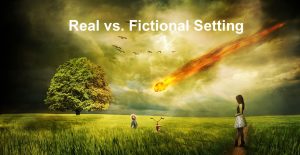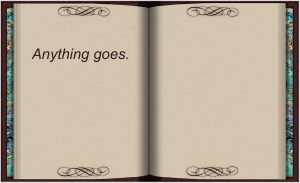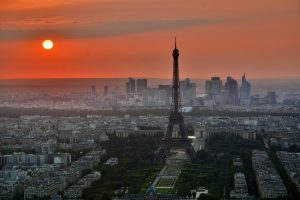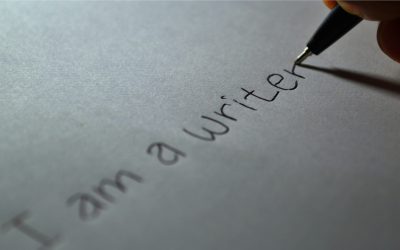First off, remember from Part 1 that setting encompasses such elements as place, time, culture, technology, geography, and weather. Thus, you must decide whether any real setting can work for your story.
Of course, fantasy and sci-fi novels need extensive fictional world building.
Advantages of Real and Fictional Story Settings
Real Settings
- It’s all laid out for you; a good map is a great help.
- Places you know well facilitate writing the setting.
- Your hometown makes research easy; everything’s a car ride away.
- You can choose from many ready-made places to enhance the mood of your story. (For a somber mood, perhaps the rainy Northwest)
- Actual places give readers a sense of authenticity within the fiction.
- Places familiar to readers readily supply them with clear images at the story’s outset. Readers enjoy being transported to places they know.
- Real places can help book sales to people who reside there or to visitors who’ve enjoyed the area.
Fictional Settings
- Anything goes, as long as it makes sense to the reader.
- You can still employ a mix of real-setting features but give them fictional names.
- You don’t have to worry about describing actual landmarks, weather, and geography that don’t live up to readers’ expectations or are wrong.
- You can develop the setting to fit the needs of your story: a local business, characters’ outdoor interests, and the area’s traditions.
Disadvantages of Real and Fictional Settings
Real Settings
• You may offend readers who know or love the place, especially if you make statements they consider derogatory.
• You must get your facts right about all elements of the setting, such as geography, weather, and time period.
• You may expect readers to know renowned places as well as you do and unconsciously leave out descriptions they need.
• You could lose sales if book reviews say you did a poor job of presenting a country, state, city, or town.
• You may spend much time researching accurate details on a small town to satisfy only a tiny portion of your readers.
Fictional Settings
- Developing all the elements of setting can be labor intense.
- You must ensure the setting elements you develop don’t work against other elements in your story. (In an arid spot, you have the criminal bury body parts in lush parks around the town.)
Combination Settings
Both cases require work, either in research or creating the setting. Perhaps employing a combination and using the advantages of both would help with the labor. You could create a fictional setting that is a composite of multiple real places to provide authenticity and the items your story needs. Or you might create a fictional place within a real country or state.
What to consider when deciding between a fictional or real story setting. Click to tweet.
How have you used fiction and reality in developing a book’s setting?





 RSS - Posts
RSS - Posts



Wonderful and meaningful post, Zoe. I understand completely. I have recently read three books set in places I know very well, and the authors obviously had never been to the places. I was completely disgusted. Two were historical, and the politics and histories so way off…dang, two clicks of a computer mouse to fact-check! But for contemporaries–my son took classes in trademark law for his MBA and advised making up everything. I wanted to use a real-life university I know well, and he advised against it. I know there are fair-use in fiction laws, but just being careful. One of my editors would t even let me use Wii.
Great stuff today!
Tanya, thanks for the examples you mention. I’ve used fictional places within actual places, like a fictional golf course. Golfers play their courses over and over and know them well…so well that I’d never be able to get the greens, fairways, and tees right.
Great ideas and suggestions, Zoe. In a contemporary WIP I’ve created a fictional college in a city I know well, along with a fictional ski resort, based on two actual ones, so I have the advantage of a setting I know well, without the problems you and Tanya point out.
It’s interesting, with my pre-Colombian WIP I’ve had people try to tell me a word or plant is wrong, simply based on their preconception, rather than the extensive research I have done. So, I guess you can’t please every reader! (But avoiding a lawsuit, as Tanya point out, is certainly an important point.)
Thanks, Jane for the sharing what you’ve done. I’ve seen in books, Authors mentioning up front or at the end that a place inside a city, like your ski resorts, were fictional, sort of apologizing to locals.
That is important to keep in mind. Thank you.